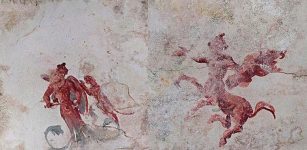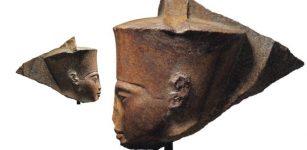Who Were The Blue People Of Kentucky?
Ellen Lloyd - AncientPages.com - People with blue skin can exist and are not a myth.
The Blue Fugates, often referred to as the Blue People of Kentucky, have long been of scientific interest. Why was their skin blue? There is a scientific explanation behind this unusual genetic condition.
Martin Fugate and his wife Elizabeth with their children c. 1820. Unknown - https://facts.net/the-fugate-family/ via Wikipedia
When the Fugate clan was first spotted, they startled people. The year was 1822, and Martin Fugate, an orphan from France, had just come to the Troublesome Creek region to start a family. Whether he had blue skin or not is uncertain as the reports vary, but it is assumed that he was blue.
An Unfortunate Coincidence - People With The Same Rare Genetic Trait Married
Martin settled in the area and married Elizabeth Smith, who was pale and had red hair. They had seven children, and four of them had blue skin. Martin and Elizabeth lived in a very isolated area, and newcomers were rarely seen there. Elizabeth was closely related to a nearby clan and may have also had some genetic abnormalities.
It led to a high level of consanguinity in marriage between families. Consanguinity, a relationship by descent from a common ancestor, can cause significant genetic disease.
At the time, Martin Fugate did not know that he had married a woman with the same rare genetic trait he had. It was an unfortunate coincidence.
The disease gene continued to spread when Zachary, one of Martin and Elizabeth's blue sons, married Elizabeth's sister.
Zachary had many children. Levy, one of his sons, married a woman from the Ritchie clan, another prominent family in the region. Together, they had eight children, including Luna, born with nearly purple skin!
Since members of the Fugates married cousins and close relatives, the blue-skinned disorder continued to thrive.
Difficult Life For The Blue People Of Kentucky
Life for the Blue people of Kentucky was not a dance on roses. All Blue Fugates were stigmatized due to their unusual appearance. Neighbors laughed at the family's blue coloring, and most avoided the Fugates. Shame, psychological trauma, and discrimination resulted in the Blue People of Kentucky isolating themselves from the rest of society.
Lorenzo, “Blue Anze” and Eleanor Fugate, circa 1915. Lorenzo was a son of Zach Fugate. Credit: Mary Fugate.
When a new baby was born, the blue color faded soon after birth, but adults often had to face lifelong suffering, being blue-skinned and different from all other human beings.
The poor Blue people of Kentucky had no idea why their skin had this unusual color, so they just tried to live everyday life. What else was there they could do?
Blue-skinned people continued living in Troublesome Creek and Ball Creek areas into the 20th century. Then, sometime in the sixties, something finally happened, and this unusual medical condition was investigated.
One day, Dr. Madison Cawein learned about some blue-skinned people who lived in Troublesome Creek. Eager to learn more about the Blue Fugates, he recruited a nurse called Ruth Pendergrass to help him in his investigations.
Ruth Pendergrass was interested because she had previously met a dark blue woman at the clinic. The blue woman had come to ask for a blood test, and her extraordinary appearance terrified Pendergrass.
"She had been out in the cold, and she was just blue! Her face and her fingernails were almost indigo blue. It used to scared me to death! She looked like she was having a heart attack. I just knew that patient was going to die right there in the health department, but she wasn't at all alarmed. She told me that her family was the blue Combses who lived up on Ball Creek. She was a sister to one of the Fugate women, "Pendergrass recalled.
Proper medical examinations conducted by Dr. Cawein and nurse Pendergrass revealed the truth about the Blue People of Kentucky. They suffered from a disease known as methemoglobinemia.
When methemoglobin levels in the red blood cell are above one percent, skin turns blue, lips become purple, and normal red blood is chocolate brown. This disease can be inherited or triggered by exposure to chemicals like benzocaine and xylocaine.
The good news for the Blue People of Kentucky was that they were cured! Dr. Cawein prescribed them daily methylene blue tablets, and the blue skin color vanished. After suffering humiliation for generations, they could finally enjoy a normal life without being ridiculed.
Born in 1975, Benjamin Stacy is the last known descendant of the Fugates. He also had blue skin, but the color vanished as he grew older.
So, no, people with blue skin are not a myth. They are not often encountered, but they can be confirmed.
Written by Ellen Lloyd – AncientPages.com Staff Writer
Updated on September 17, 2023
Copyright © AncientPages.com. All rights reserved. This material may not be published, broadcast, rewritten or redistributed in whole or part without the express written permission of AncientPages.com
Expand for referencesMore From Ancient Pages
-
 Afterlife: Ancient Egyptian Mummification Balms Studied
Archaeology | Aug 31, 2023
Afterlife: Ancient Egyptian Mummification Balms Studied
Archaeology | Aug 31, 2023 -
 Oldest Case of Decapitation In the New World – Lapa do Santo, East-Central Brazil
Civilizations | Sep 24, 2015
Oldest Case of Decapitation In the New World – Lapa do Santo, East-Central Brazil
Civilizations | Sep 24, 2015 -
 On This Day In History: World War II: Battle Of Cape Esperance Was Fought – On October 11, 1942
News | Oct 11, 2016
On This Day In History: World War II: Battle Of Cape Esperance Was Fought – On October 11, 1942
News | Oct 11, 2016 -
 Ancient Pathogens Released From Melting Ice Could Wreak Havoc On The World – New Analysis Reveals
Featured Stories | Aug 2, 2023
Ancient Pathogens Released From Melting Ice Could Wreak Havoc On The World – New Analysis Reveals
Featured Stories | Aug 2, 2023 -
 Drones Discover 25 Never-Before-Seen Geoglyphs Near Famous Nazca Lines
Archaeology | Jun 4, 2018
Drones Discover 25 Never-Before-Seen Geoglyphs Near Famous Nazca Lines
Archaeology | Jun 4, 2018 -
 Sphinx Room Discovered At Emperor Nero’s Famed Domus Aurea (Golden House)
Archaeology | May 9, 2019
Sphinx Room Discovered At Emperor Nero’s Famed Domus Aurea (Golden House)
Archaeology | May 9, 2019 -
 On This Day In History: The Warsaw Uprising Began – On August 1, 1944
News | Aug 1, 2016
On This Day In History: The Warsaw Uprising Began – On August 1, 1944
News | Aug 1, 2016 -
 New Archaeological Discoveries In The Temple Of Khnum At Esna, Luxor
Archaeology | Dec 29, 2022
New Archaeological Discoveries In The Temple Of Khnum At Esna, Luxor
Archaeology | Dec 29, 2022 -
 Surprising Mask Of A Human Face Found On Cistern Wall In The Ancient City Of Ptolemais
Archaeology | Jan 17, 2025
Surprising Mask Of A Human Face Found On Cistern Wall In The Ancient City Of Ptolemais
Archaeology | Jan 17, 2025 -
 Evidence Of An Ancient Roman Oracle Cult Found In Ostia, Italy
Archaeology | Jun 18, 2024
Evidence Of An Ancient Roman Oracle Cult Found In Ostia, Italy
Archaeology | Jun 18, 2024 -
 Ganesha: Elephant-Headed God Of Knowledge, Learning, Literature And Scribe Of The Mahabharata
Featured Stories | Aug 17, 2016
Ganesha: Elephant-Headed God Of Knowledge, Learning, Literature And Scribe Of The Mahabharata
Featured Stories | Aug 17, 2016 -
 Magnificent Ancient Treasures Of The Mysterious Kangju Kingdom Found By Archaeologists
Archaeology | Jun 11, 2024
Magnificent Ancient Treasures Of The Mysterious Kangju Kingdom Found By Archaeologists
Archaeology | Jun 11, 2024 -
 Unexpected Archaeological Discovery May Re-Write English Civil War History
Archaeology | Feb 3, 2023
Unexpected Archaeological Discovery May Re-Write English Civil War History
Archaeology | Feb 3, 2023 -
 1,500-Year-Old Inscription ‘Christ, Born Of Mary’ Engraved On Magnificent Building Discovered In Israel
Archaeology | Jan 21, 2021
1,500-Year-Old Inscription ‘Christ, Born Of Mary’ Engraved On Magnificent Building Discovered In Israel
Archaeology | Jan 21, 2021 -
 Egypt Calls On Christie’s Auction House In London To Stop Sale Of Tutankhamun Statue Head
Archaeology | Jun 14, 2019
Egypt Calls On Christie’s Auction House In London To Stop Sale Of Tutankhamun Statue Head
Archaeology | Jun 14, 2019 -
 Can This Ancient Underwater Graveyard Solve The Mystery Of The Great Flood And Noah’s Ark?
Archaeology | Oct 23, 2019
Can This Ancient Underwater Graveyard Solve The Mystery Of The Great Flood And Noah’s Ark?
Archaeology | Oct 23, 2019 -
 Mystery Of The Lavau Celtic Prince And The Beautiful Ancient Artifacts Hidden In His 2,500-Year-Old Tomb
Archaeology | Jun 5, 2017
Mystery Of The Lavau Celtic Prince And The Beautiful Ancient Artifacts Hidden In His 2,500-Year-Old Tomb
Archaeology | Jun 5, 2017 -
 Chilling Graffiti Found In 1,600-Year-Old Roman Prison In Corinth, Greece
Archaeology | Aug 19, 2024
Chilling Graffiti Found In 1,600-Year-Old Roman Prison In Corinth, Greece
Archaeology | Aug 19, 2024 -
 God Patecatl – Father Of ‘Four Hundred Rabbits’ In Aztec Beliefs
Aztec Mythology | Mar 9, 2018
God Patecatl – Father Of ‘Four Hundred Rabbits’ In Aztec Beliefs
Aztec Mythology | Mar 9, 2018 -
 Ancient Expensive Roman Domus With Beautiful Mosaic Unearthed In Rome
Archaeology | Dec 17, 2023
Ancient Expensive Roman Domus With Beautiful Mosaic Unearthed In Rome
Archaeology | Dec 17, 2023


